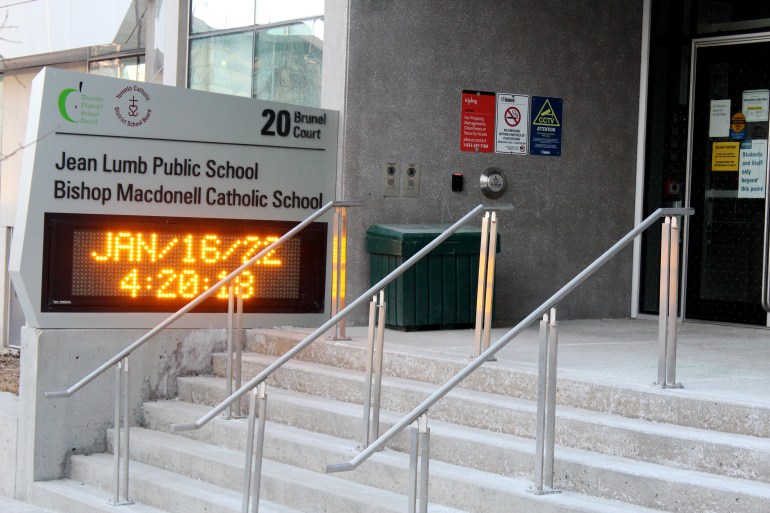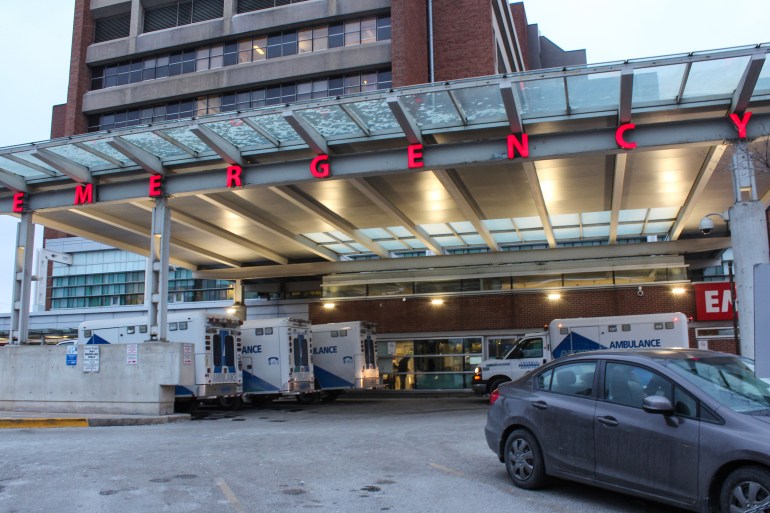Parents say they are frustrated by Canadian province’s school policies, as thousands set to return to class this week.
By Usaid Siddiqui
Toronto, Ontario – Schoolchildren in Canada’s most populous province are going back to their classrooms this week, after many parents said they were left scrambling to respond to the Ontario government’s decision earlier this month to delay in-person learning.
Ontario Premier Doug Ford announced on January 3 that the province would push back the planned return to in-person classes from January 5 to January 17 due to rising COVID-19 infections and hospitalisations linked to the Omicron variant.
Some public health experts had called for a longer closure period, cautioning that Omicron’s threat to schools was high and calling for more targeted measures to prevent its spread.
Prime Minister Justin Trudeau also recently said child vaccination rates were lagging and urged parents to get their children vaccinated. As of January 17, about 44 percent of children between the ages of five and 11 have had their first dose in Ontario, compared with 86 percent of children aged 12 to 17.
But the way the Ontario government communicated its post-holiday schools plan – saying first that classes would resume on January 3, then on January 5, and then on January 17 – raised frustrations among some parents who said the province gave them little time to prepare.

Now, as thousands of students are set to go back to class this week, parents and public health experts have called on Ontario to make sure schools are safe, better explain its pandemic-related measures, and give families more time to plan ahead when it makes a decision.
“They needed to speak in clear language,” business owner and Toronto resident Manal Siddiqui told Al Jazeera.
“Like, ‘If cases get beyond this point, this is what will happen. This or that [rise in cases] will trigger a shutdown or school closure,’” said Siddiqui, who has two children aged two and five. “Instead, we were left up a creek without a paddle.”
Safety measures
The Elementary Teachers’ Federation of Ontario (ETFO) union welcomed the school closures earlier this month, saying additional time was needed to implement safety measures. It also said a two-day delay in reopening – as originally planned – would have been “dangerously close to risking the safety of students”.
Ontario has recorded more than 956,000 cases of COVID-19 and more than 10,000 deaths linked to the coronavirus since the start of the pandemic.
But the rate of daily infections per 100,000 people surged from 22.3 on December 18 last year, to 91.6 on January 6. As of January 16, the rate was 71.7. Experts have said case counts are likely higher, however, due to current limitations on testing.
Ontario Education Minister Stephen Lecce told Al Jazeera in an email on January 11 that the government’s priority is “getting students back to class”. Leece said the province “is continuously investing in safer schools through enhanced ventilation, quality PPE, and additional vaccine clinics offering targeted appointments for education staff”.
“Ontario has consistently strengthened our plan to keep schools as safe as possible, going above public health guidance,” said Leece, including by deploying N95 masks for education and childcare workers and improving air ventilation in schools, among other measures.
Nevertheless, many parents are not convinced by the government’s assurances that school safety has been improved during the past two weeks.
“I haven’t heard anything from my kids school about N95 masks,” Sara Fung, a registered nurse, community health worker and mother of two, told Al Jazeera. “My son’s teacher is checking if there is a HEPA filter in the classroom so that doesn’t sound like a definite yes,” said Fung, who lives in Hamilton, Ontario, about 58km (36 miles) west of Toronto.
Many parents say another order to close schools would be extremely difficult to manage – and that is why classroom safety measures are so crucial.
The need to return to in-person learning is especially pressing for children with disabilities, said Jacqui Robbins, the preschool manager at Centennial Infant & Child Centre (CICC), a school for children with special needs in Toronto.
“The virtual format is simply not accessible to many children,” she told Al Jazeera. “It’s easy to see how this would be true for children with hearing or visual impairment. But it’s also true for our children with any kind of attentional difficulties, physical disabilities that make sitting upright for long periods difficult, or photosensitive seizure disorders.”

Other parents, such as physical education teacher Asma, who asked Al Jazeera not to use her full name in order to speak freely, have urged the government to mandate COVID-19 jabs for children to make classrooms safer. Ontario schools already require proof of vaccination for other diseases, including measles and mumps.
“I understand the fear … of the vaccine,” Asma, a mother of two school-aged children, told Al Jazeera. “However, we are living in unprecedented times.”
‘Failure to get ahead’
While a vaccine mandate for children in Ontario or elsewhere in Canada is unlikely, health experts have said authorities should focus on making sure schools are as safe as possible to prevent the virus from spreading.
“There is no question that schools should be open, but the challenge is how do we keep these schools safe,” Andrew Boozary, executive director of social medicine and population health at University Health Network in Toronto, told Al Jazeera.
In addition to HEPA filters and N95 masks, Boozary said it was vital to coordinate a rapid antigen testing programme with “granular reporting” – by sending out data in real-time to parents and educators.
He said Ontario should guarantee at least five paid sick days per year to support families. “If a family member tests positive, they should be able to stay at home without the pressure of returning to work, said Boozary, adding that it will be “incredibly stressful and damaging” for essential workers without paid sick leave to keep children in schools.

Boozary also pointed to reports of paediatric COVID-19 hospitalisations in the province as particularly alarming.
“With the rise of Omicron, hospitals are starting to see a disturbing, potential new trend – admissions of infants with COVID-19 … Since the middle of December, CHEO and McMaster Children’s Hospital have admitted a total of six babies under the age of 12 months because of COVID-19 infection,” four Ontario hospitals said in a joint statement on January 5.
According to statistics from Public Health Ontario, 73 children under age five were admitted to hospital with the coronavirus between December 30 to January 13, compared with 19 between December 16 and 30, The Globe and Mail newspaper also reported.
“There has been a failure to get ahead [of each wave]. We cannot wait for lagging indicators [like hospitalisations]. When we only have reactive policies, it leads to catastrophic consequences,” Boozary said. “In too many cases policymakers have been banking on the heroism of health workers and honestly it’s not sustainable.” Source: Al Jazeera
“Ontario has consistently strengthened our plan to keep schools as safe as possible, going above public health guidance,” said Leece, including by deploying N95 masks for education and childcare workers and improving air ventilation in schools, among other measures.
Nevertheless, many parents are not convinced by the government’s assurances that school safety has been improved during the past two weeks.
“I haven’t heard anything from my kids school about N95 masks,” Sara Fung, a registered nurse, community health worker and mother of two, told Al Jazeera. “My son’s teacher is checking if there is a HEPA filter in the classroom so that doesn’t sound like a definite yes,” said Fung, who lives in Hamilton, Ontario, about 58km (36 miles) west of Toronto.
Many parents say another order to close schools would be extremely difficult to manage – and that is why classroom safety measures are so crucial.
The need to return to in-person learning is especially pressing for children with disabilities, said Jacqui Robbins, the preschool manager at Centennial Infant & Child Centre (CICC), a school for children with special needs in Toronto.
“The virtual format is simply not accessible to many children,” she told Al Jazeera. “It’s easy to see how this would be true for children with hearing or visual impairment. But it’s also true for our children with any kind of attentional difficulties, physical disabilities that make sitting upright for long periods difficult, or photosensitive seizure disorders.”

Other parents, such as physical education teacher Asma, who asked Al Jazeera not to use her full name in order to speak freely, have urged the government to mandate COVID-19 jabs for children to make classrooms safer. Ontario schools already require proof of vaccination for other diseases, including measles and mumps.
“I understand the fear … of the vaccine,” Asma, a mother of two school-aged children, told Al Jazeera. “However, we are living in unprecedented times.”
‘Failure to get ahead’
While a vaccine mandate for children in Ontario or elsewhere in Canada is unlikely, health experts have said authorities should focus on making sure schools are as safe as possible to prevent the virus from spreading.
“There is no question that schools should be open, but the challenge is how do we keep these schools safe,” Andrew Boozary, executive director of social medicine and population health at University Health Network in Toronto, told Al Jazeera.
In addition to HEPA filters and N95 masks, Boozary said it was vital to coordinate a rapid antigen testing programme with “granular reporting” – by sending out data in real-time to parents and educators.
He said Ontario should guarantee at least five paid sick days per year to support families. “If a family member tests positive, they should be able to stay at home without the pressure of returning to work, said Boozary, adding that it will be “incredibly stressful and damaging” for essential workers without paid sick leave to keep children in schools.

Boozary also pointed to reports of paediatric COVID-19 hospitalisations in the province as particularly alarming.
“With the rise of Omicron, hospitals are starting to see a disturbing, potential new trend – admissions of infants with COVID-19 … Since the middle of December, CHEO and McMaster Children’s Hospital have admitted a total of six babies under the age of 12 months because of COVID-19 infection,” four Ontario hospitals said in a joint statement on January 5.
According to statistics from Public Health Ontario, 73 children under age five were admitted to hospital with the coronavirus between December 30 to January 13, compared with 19 between December 16 and 30, The Globe and Mail newspaper also reported.
“There has been a failure to get ahead [of each wave]. We cannot wait for lagging indicators [like hospitalisations]. When we only have reactive policies, it leads to catastrophic consequences,” Boozary said. “In too many cases policymakers have been banking on the heroism of health workers and honestly it’s not sustainable.”
Source: Al Jazeera


